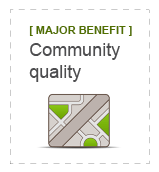Along with city trees, city parks and trails soften our daily life spent in buildings, satisfying an innate affinity for the natural world. These green and open spaces can be a defining feature of a city, providing civic gathering spaces, venues for exercise and cost-free recreation, and connections to open space beyond city limits. City parks and trails provide many important ecosystem services, including the purification of air, reduction in the urban heat island effect, stormwater management, wildlife habitat, and carbon sequestration. Parks and trails are also economic development tools, increasing property values in their vicinity. For example, a $14 million bonus of 2008 tax revenue from ten GreenStep cities in Hennepin County was attributable to homes located within a half-mile of green space.
And finally, trails can serve important transportation functions, connecting recreational destinations, job centers, retail centers, schools, neighborhoods and points beyond the city.


